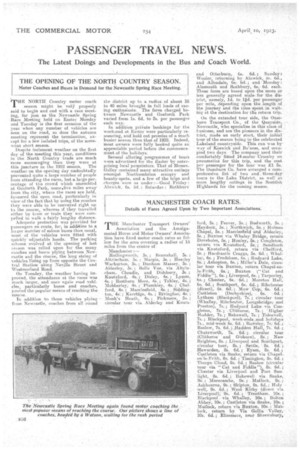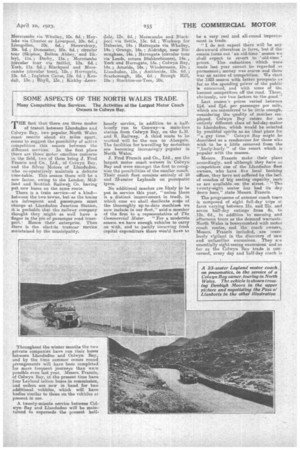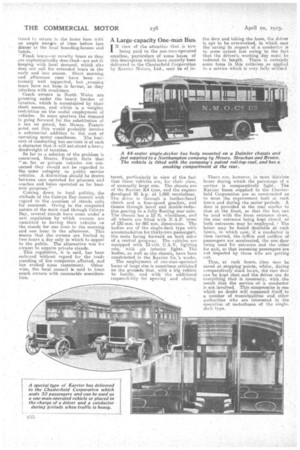PASSENGER TRAVEL NEWS.
Page 22

Page 23

Page 24

If you've noticed an error in this article please click here to report it so we can fix it.
The Latest Doings and Developments in the Bus and Coach World.
THE OPENING OF THE NORTH COUNTRY SEASON.
Motor Coaches and &ties in Demand for the Newcastle Spring Race Meeting.
THE NORTH. Country motor coach season might be ve-ty properly said to begin and end with a race meeting, for just as the Newcastle Spring 'Race Meeting held on Easter Monday and Tuesday is the first occasion of the year when any number of. vehicles are seen on the road, so does the autumn meeting represent the termination, except for a few isolated trips, of the somewhat short season.
Despite inclement weather on the first day of the meeting this year, conditions in the North Country trade are much more encouraging than they were at this j-uncture in the 1922 season. The weather on the opening day undoubtedly prevented quite a large number of people from attending the races, but a large percentage of the crowd which assembled at Gosforth Park, some,five miles away from thi3 city, where the races are held, favoured the open road, particularly in view of the fact that by using the coaches they were able to be conveyed right up tc, the course, whereas if they travelled either by train or train they were compelled to walk a fairly lengthy distance. Adequate protection was provided for passengers en•route, for, in addition to a linger number of saloon buses than usual, most of the vehicles were fitted: with quickly -adjustable hoods. The parking scheme evolved at the open big of last reason was relied upon for the many coaches and buees plying between Newcastle and the course, the long string of vehicles lining up from opposite the Central Station! along Neville Street and Westmorland Bond.
On Tuesday, the weather haying improved, the attendance at the races was much larger,and once again road vehicles, particularly buses and coaches, ',Dived the popular means of reaching the course.
In addition to those vehicles plying from Newcastle, coaches from all round the district up to a radiui of about 35 to 40 miles brought in full loads of-racing enthusiasts. The fares charged between Newcastle and Gosforth Park varied from is. 6d. to 2s. per passenger each way.
In addition private bookings for the week-end at Easter were particularly reassuring, and hold out promise of a much busier se-aeon than that of 1922. Indeed, most owners were fully booked quite an appreciable period before the commencement of the holidays.
Several alluring programmes of tours were advertised for the Easter by enterprising local proprietors. That of Messrs. Galley contained many attractive outings amongst Northumbrian scenery and beauty-spots, and a few of the trips and charges were as under a---Good Friday : Alnwick, 6s, 6c1. : Saturday : Rothbury and Otterburn, 6s. 6d.; Sunday: Weoler, returning by Alnwick, 6s. 6d., and Allendale, 6s. 6d.; and Monday Alnmouth and Rothbury, 6s. 6d. each These fares are based upon the more or less generally agreed scale for the disarict, namely, id. to lid. per passenger per mile, depending upon the length of the journey and the time spent in.weitjug at the destination for the return trip.
On the extended tour gide, the Ouseborn Transport Co., of the Quayside, Newcastle, who specialize in this class of . business, and are the pioneers in the district, Made an early start, their initial tour of the season being to the celebrated Lakeland countryside. This run was byway of -Keswick and Bo'ness, and occupied two days The company used their comfortably fitted 14-seater Crossley on pnetimatieS for this trip, and the cost per passenger for the tour was £1 5s. The Ouseburn Co. have arranged a comprehensive list of • two and three-day tours to the Lake District, as well as more lengthy outings in the Scottish Highlands for the coming season.
MANCHESTER COACH RATES.
Details of Fares Agreed Upon by Two Important Associations.
THE Manchester Transport Owners' ASSOCi at i on and tho Amalgamated Horse and Motor Owners' Association have fixed motor coach rates as follow for the area covering a radius of 15 miles from the centre of
Manchester
ng wort h , 3s. ; Bra.mshall. 3s. ; Altrincham, 3s. ; Marple, 3s. Ifeatley Warburton, 3s.-; Dunham Massey, 3s. ; Alderley, 3s. ; Belle Mue, via Altrincham, Cheadle, and Didshury, 3e. ; Knutsford, .4s. ; Disley, 4s. ; Lyinm, 4s.; Rosthern Mere, 4s. ; Tabley, 4s, ; Mobberley, 4s.; Plunibley,• 4s: e Chetford. 4s. • Maeeleafield 4a • _ Siddirigton, 4.5:; Kerrie, 4s. ; Rivingfoe; 4,s: ; Monk's Heath, 4s. ; Pickmere, 5s. ; circular tour via Alderley and Knuts
ford, 5s. ; Peover, 5s.; Buclworth, 5s. ; Haydock, 5s. ; Northwich, 5a.; Holmes Chapel, 5s.; MaccleafifClel and Alderley, Gs.; Buxton via Whaley Bridge, return Doveholes, 5s.; Honley, 5g.; Congleton, return via Knutsford, 5s.; Sandbech via Knetsford, return via .Chelfiird, 5s. ; Haialcastle Crag(s, 5s. 6d. ; Whalley, 6s.; Frodsham, 6s.; Radyard Lake, •
6s.; Ashopton, Gs.; Dale, circular tour via Buxton, return Chapel-enle-Frith; 6s.; Buxton (" Cat and Fiddle"), 6.s.; Liverpool, 6s. ; Tarporley, .6s. ; Chester, 6s. 6c1.; Moreton Hall, 6s. 6d.; Southport, 65. 0d. ; Ribehester (direct), 6a. 6d..; Mow Cop; 6s.• 6d. ; Caatleton (Derbyshire), 6s. 6d. ; Lytham (Blac(pool),7a.; circular tour (Whalley, Ribehester, Longsbridgee and Preston), 7s.; Ruilyard Lakevia Congleton, TS.; • Clitheroe, 7s.; Higher Hodder, 7a...; Bakewell, • 7s. ; 7s.; Blackpool, week-ends .and holidays Is., mid-week .6a. 6d. ; P,owsley, 7s: 6c1..; Baslow, 7s. 6d. Haddon Hall, .7.s, .6d.; Chatsworth, 7s. 6cl a circular tour (Clitheroe and Gisliurn), 8s..; New Brighton, 8s. ; Liverpool -and Southport, circular tour, 8s.; Settle, 8s. 6d. ;. Hawarden, Be. 6d.; Eyam, 8s. 6.d. • Castleton via Snake; return via Chapefenlle-Frith, 8s. 6d. ; Tissington, 8s. 6d. ; Thorpe Cloud, 8s. 6d.; Bestow (circular tout via " Cat and Fiddle"), 8s. eal. Chester via LiverPool and Port Sunlight, Be. 6d. ; Bake-well via Snake, 9a. ; Morecambe, -9e. ; Matlock. ;Ashboarne, 9s.; Skipton., 9s. 6d.; Holy • well, 9s. ,6d. ; ,West Kirby (direct via Liverpool); 9s, 6d. ; Trentham, 10s. ;_ Blackpool via Whalley, 10s.; 13olton Abboy, 10s. ; Castleton via Snake, 10s.; Matlock, return via Buxton, 10s. ; Matlock, return -hy Via Genie .
10s. 6d.; Ellesmere; near Shrewsbury, Morecambe via Whalley, 10s. 6d. ; Hoy. lake via Chester or Liverpool, 10s. tat.; Llangollen, 10s. 6d.; Shrewsbury, 10s. 6d. ; Doncaster, 10s. 6d.; circular tour (Skipton, Bolton Abbey, and Ilkley), lie. ; Derby, 11a. ; Morecambe (circular tour via Settle), 11s. 6d. ; York, lls. 6d.; Blackpool and Morecambe (circular tour), 12s.; Harrogate, 12s. 61; Ingieton Caves, 12.s. 6d. ; Kendall, 13s.; Rhyll, 13s.; Kirkby -Lions
dale, 13s. 6d. ; Morecambe and BlackPool via, Settle, 13s. 6d. ; Worksop for Dukeries, 14s. ; Hahogate via Whalley, 14s.) Grange, 14s. ; Aldridge, near Birmingham, 14s.; Harrogate (circular tour via' Leads, return Blubberhouses), 14a, York and Harrogate, 14a.; Colwyn Bay, 14s.; Arnside, 14s. ; Windermere, 15s.; Llandudno 15s. ; Ambleside, 15s. 6c.; Scarborough, 18s. 6d. ; Brough Hill, 19s.; Stockton-on-Tees, 20s.
SOME ASPECTS OF THE NORTH WALES TRADE.
Many Competitive Bus Services. The Activities of the Largest Motor Coach Owners in Colwyn Bay.
THE fact that there are three modes of transit between Llandudno and Colwyn Bay, two popular North Wales coast resorts about six miles apart, seems to suggest the possibility of active competition this season between the different services. In the first place there are three" motor omnibus concerns in the field, two of them being J. Fred Francis and Co., Ltd., of Colwyn Bay, and the Silver Motors of Llandudno, who co-operatively maintain a definite time-table. Tins season there will be a now factor, owing to the hondon, Midland and Scottish Railway, Co. baying put new buses on the same route.
There ia a train service-of a kindbetween the two towns, but as the trains are infrequent and passengers must change at Llandudno Junction Station, it is probable that the railway company thought they might as well have a finger in the pie of passenger road transport.Hence their enterprise. Then there is the electi-ic tramcar .service maintained by the municipality.
Throughout the winter months the two private companies have run their bases between Llandudno and Colwyn Bay, and by the time summer comes round arrangements will have been completed lotmore frequent journeys than were possible even last year Messrs. Francis, of Colwyn Bay, at. the present time have four Leyland saloon buses in commission, and orders are now in hand for two additional -vehicles, which will have bodies similar to those on the vehicles at present in use.
A twenty-minute service between Celvnin Bay and Llandudno will be maintained to supersede the present halt.
hourly service, in addition to a half. hourly run to Conway-a main-line station from Colwyn Bay, on the, L.M. and S. Railway. A third route to he worked will b the one to Aborgele. Tho facilities for travelling by motorbus are becoming increasingly popular in North Wales.
a. Fred Francis and Co., Ltd., are the largest motor coach owners in Colwyn I-lay and were amongst the first to rec.ognige the possibilities of the smaller coach. Their coach fleet consists entirely of 19 and 23-seater Leylauds on pneu atic tyres.
. No additional coaches are likely o be put in service this year, " unless here is a. distinct improvement in trad , in which case we shall dirolicate soi4e of the thoroughly up-to-date machinet we now include in our fleet," said a member of the firm to a representative of The mmereialMeter. " For a moderate season we have enough vehicles to carry on with, and to justify incurring fresh capital expenditure there would harts to be a very real and all-round improvement in trade.
"I do not expect there will be any downward alteration in fares, but if the season turns not 'an old-time' season we shall expect to revert to prices. The reductions which were made lut year cannot be regarded 43 permanent; money was scarce and there was an excess of competition. We start the 1923 season with better prospects sa far as the spending power of the public is concerned, and with some of the keenest competitors off the road. These, obviously, are two factors to the good."
Last season's prices varied between lid. and 21.d. per passenger per mile, which are considered to be little enough, considering the quality of coaches em.. ployod. CnIwyn Bay caters fur an entirely different class of holiday-soaker to Llandudno, which would be selected by youthful spirits as an ideal place for "a gay time." Colwyn Bay might be described as a rendezvous for those who wish to be a little removed from the ",burly-burly " of the resort which is popular with the masses.
Messrs. Francis make their plans accordingly, and although they have as competitors one of the Llandudno fleet owners, who have five local booking offices, they have not suffered by the lack of coaches of big seating capacity, such as are available. on the street. " The twenty-eight seater has had its day down here," state Messrs. Fra.ncis.
The programme of summer coach tours is composed of eight full-day trips at fares varying between 15s. and 21s. and seven half-day outings from 4s. to 12s. 6d., in addition to morning and afternoon tours as the demand warrants. North Wales is honeycombed with motor coach routes, and the coach owners, Messrs. Francis included, are ceaselessly vigilant in the discovery of new and unfamiliar excursions. They are essentially sight-seeing excursions. and an far as the Colwyn gay trade is con: earned, every day and half-day coach is
timed to return to the home base with an ample margin of time before late dinner at the local hoarding-houses and hotels. • -• Freak tours—or-novelty tours as they are euphernistically described—are not in keeping with local demand, which also does not call for extended tours in the early and late season. Short morning and afternoon runs have been ex treinely well supported, but .evening tours have not been in favour, as they interfere with mealtimes. •
Coach oWners in North Wales are groaning under the heavy burden of taxation, which is accentuated by their short season, and which is a weighty restriction on the useful employment of vehicles. In some quarters the demand is going forward for the substitution of a tax on petrol, but Messrs. Francis point out this would probably involve a., substantial addition to the cost of operating motor omnibuses, The bus-'less of conducting bus services is of such a character that it will not stand a heavy deadweight of taxation.
So far as a solution of the problem is concerned, Messrs. Francis state that " so far as private vehicles are concerned they should not be regarded in the same category as public service vehicles. A distinction should be drawn between cars operated for .pleasure and coaches and buses operated as for business purposes."
Coming down to local politics, the attitude of the Colwyn Bay council with regard to the question of stands calls for comment. Owing to the congested nature of the main road through Colwyn Bay, several stands have come under a new regulation by which owners are restricted to having their vehicles on the stands for one hour in the morning and one hour in the afternoon. This means that the owners are limited to two hours a day only in which to appeal to the public. The alternative was fur owners to acquire private stands.
.. This regulation, it is said, has been enforced without regard for the trade standing of the companies Affected, and has evoked some resentment. Other wise, the local council is said to treat coach owners with reasonable sionsideration.
A Large-capacity One-man Bus4
N view of the attention that is now . being paid to the one-rnau-operated • omnibus, particulars of some buses of this description which have recently been delivered to the Chesterfield Corporation by Karrier Motors, Ltd., may be of in
terest particularly in view of the fact that these vehicles are, foe their class, of unusually large size. The chassis are of the Karrier K4 type, and the engines developed 59 h.p. at 1,000 revolutions. The drive is through a. leather-facial clutch and a four-speed gearbox, and thence through bevel and double-Iedue tion gearing to a fully floating rear axle. The chassis has a 15ft. Wheelbase, and all wheels are. fitted with N.A.P. tyres of 130 mm. by 881 ram. dimensions. The bodies are of the single-deck type with accommodation for thirty-two passengers. the seats facing forward on both sides of a central gangway. The %chicle:: ars equipped with 12-volt C.A.V. lighting sets, with six interior lights. The bodies, as well as the chassis, have been constructed in the Karrier Co.'s works.
The employMent of one-man-operated buses of large size is sometimes criticised on the groan& that, with a big vehicle to handle, and with the additional responsikility for opening and closing
the door and taking the fares, the driver is apt to be overworked, in which case the •saving in respect of a conductor is to some .extent lost owing to the fact that the drivers working day musr be redirect' .in. length. :There is certain some force in 'this Criticism..as applied to a service Which Is very fully utnizecl . There are, however, in most districts hours during which the patronage of a service is comparatively light, The Karrier buses supplied to the Chesterfield Corporation are so constructed as to meet the requirement both at rush hours and during the easier periods. A door is provided at the rear similar to that at the front, so that the bus can be us'ed with the front entrance ;dime, the rear entrance being kept closed, or both entrances may be employed. • The latter may be found -desirable at rush hours, in which case, if a conductor is then carried, the inflow and outflow of passengers •are accelerated, the one door being used fcir entrance and the other for exit, so that incoming passengers are rot impeded by those who are getting c.ut.
Thus, at rush hours, time may be saved at stopping points, whilst, dering comparatively slack hoars, tile rear door can be kept shut. and the driver can do everything that is necessary, with the result that the service ,of a conductor is not involved. This compromise is one which no doubt will commend -itself to a number of municipalities and other authorities who are interested in the operation of motorbuses of the singledeck type.






























